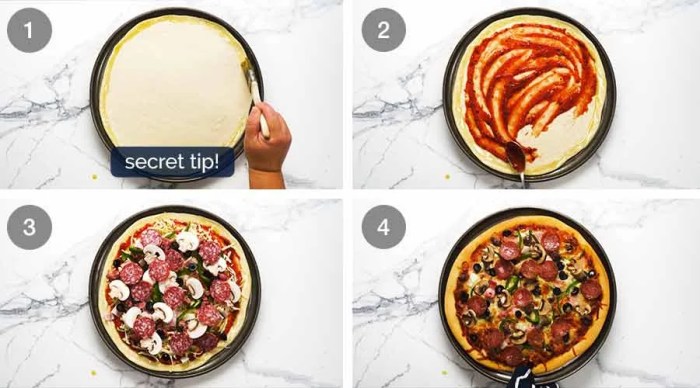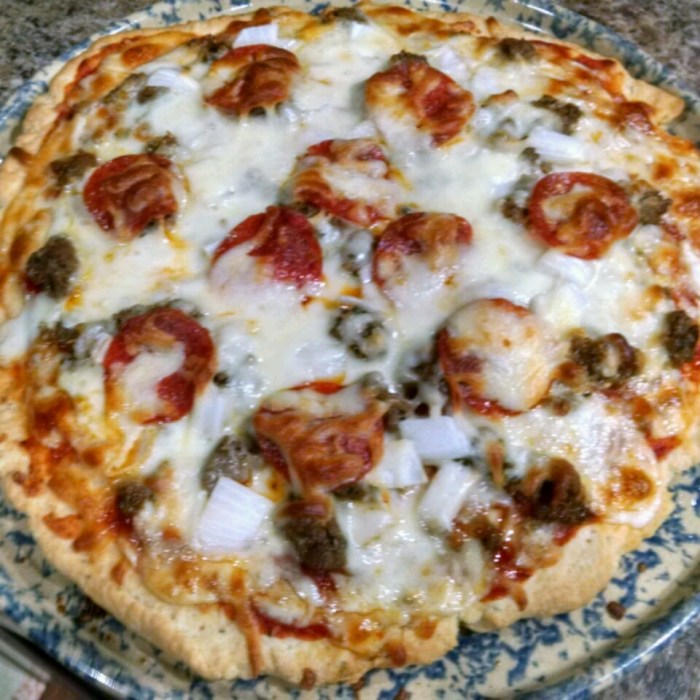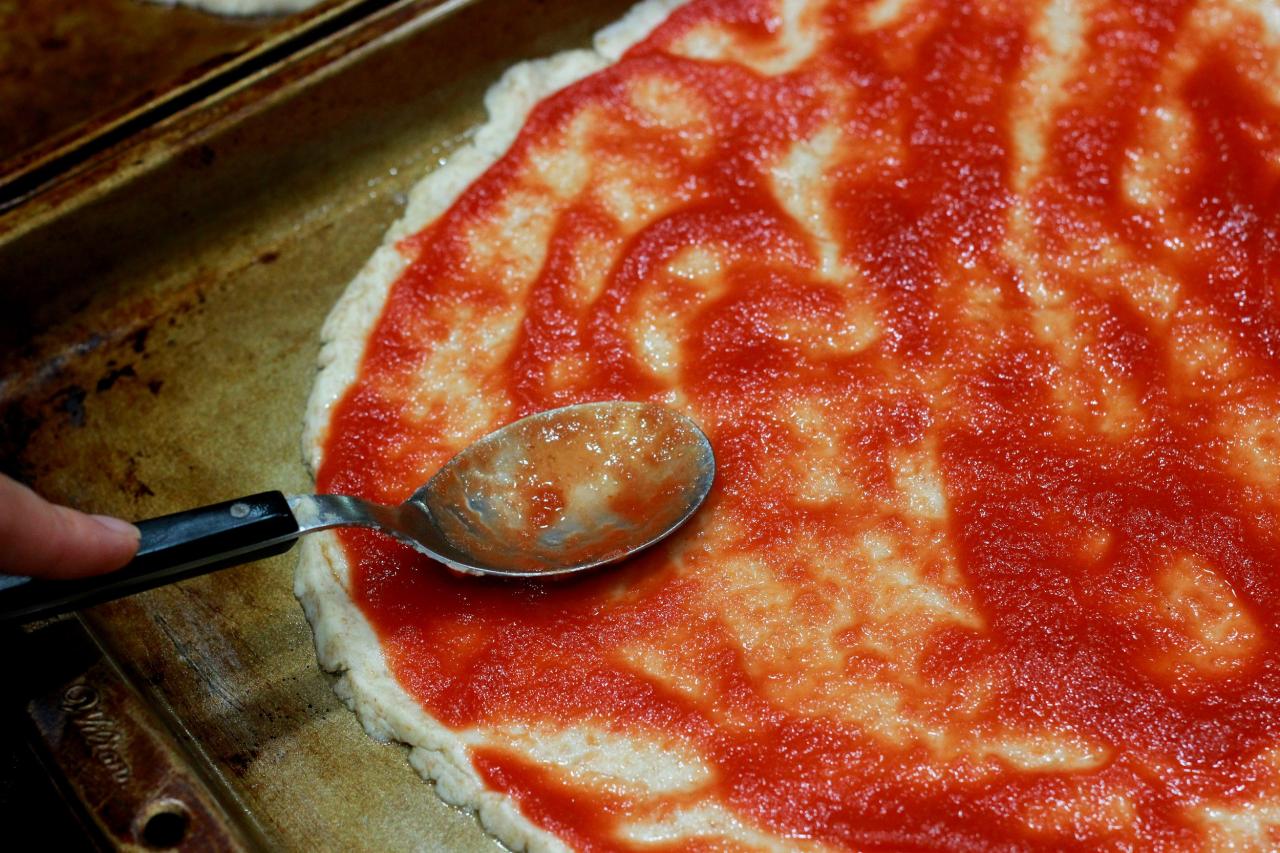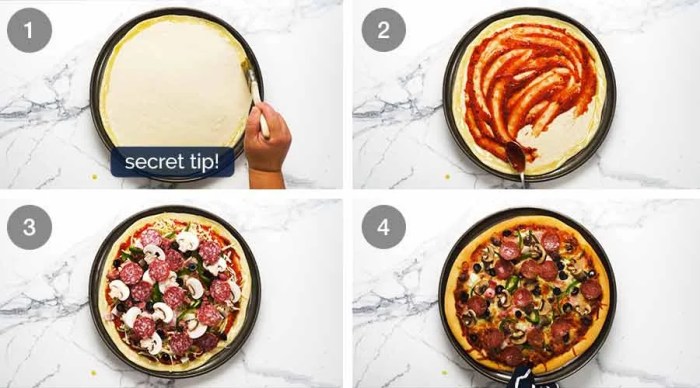
No Yeast Pizza Crust: Easy & Delicious
No yeast pizza crust opens up a world of pizza possibilities for those who want to skip the waiting and rising time associated with traditional dough. This simple and versatile crust is perfect for weeknight meals, impromptu gatherings, or anyone who wants to avoid the hassle of yeast.
It’s all about quick, easy, and delicious, making it a true kitchen hero.
This blog post dives into the fascinating world of no-yeast pizza crusts, exploring the various types, techniques, and endless possibilities for customization. We’ll uncover the secrets behind creating a perfectly crispy and flavorful crust, and share tips and tricks to help you become a no-yeast pizza master.
Whether you’re a seasoned baker or a kitchen novice, this guide has something for everyone.
Introduction to No-Yeast Pizza Crust
No-yeast pizza crust is a simple and convenient alternative to traditional yeast-based dough. This type of crust doesn’t require any yeast to rise, making it a great option for busy weeknights or for those who prefer a less time-consuming approach to pizza making.No-yeast pizza crust offers several benefits over traditional yeast-based dough.
It requires less time to prepare, as it doesn’t need to rise, and is often easier to work with, as it doesn’t require any special kneading techniques. This makes it an ideal choice for beginners or those who don’t have a lot of experience with baking.
No-yeast pizza crust is a lifesaver for those nights when you crave pizza but don’t have the time to wait for dough to rise. It’s also a great option for those who are avoiding yeast for dietary reasons. I love pairing my no-yeast pizza with a yummy honey mustard dipping sauce – the sweet and tangy flavors complement the crust perfectly.
Whether you’re a seasoned pizza pro or a newbie in the kitchen, no-yeast pizza is a simple and delicious option that can be enjoyed by all.
Additionally, no-yeast crusts tend to be crispier and less chewy than yeast-based doughs, which some people prefer.
Popular No-Yeast Pizza Crust Recipes
Here are some popular no-yeast pizza crust recipes and their variations:
- Flour-based crusts: These are the most common type of no-yeast crusts and typically use a combination of all-purpose flour, water, and oil. Some recipes may also include other ingredients such as baking powder, salt, or herbs. Flour-based crusts can be rolled out or pressed into a pan, and they can be baked directly on a baking sheet or on a pizza stone.
- Self-rising flour crusts: These crusts use self-rising flour, which already contains baking powder and salt. This makes them even easier to prepare, as you don’t need to add any additional ingredients. Self-rising flour crusts are typically rolled out or pressed into a pan and baked directly on a baking sheet.
- Tortilla-based crusts: These crusts use tortillas as the base, making them a quick and easy option. You can use any type of tortilla, but flour tortillas are generally preferred. Simply spread your favorite pizza toppings on the tortilla and bake until the cheese is melted and bubbly.
This method is particularly popular for making personal pizzas.
- Pita bread crusts: Similar to tortilla-based crusts, pita bread can be used as a base for pizza. You can use whole wheat pita bread or white pita bread, depending on your preference. Simply spread your toppings on the pita bread and bake until the cheese is melted and bubbly.
Ingredients and Techniques
No-yeast pizza crust recipes are known for their simplicity and versatility, requiring minimal ingredients and preparation time. The key to achieving a delicious and satisfying crust lies in understanding the role of each ingredient and mastering the techniques involved.
Ingredients Used in No-Yeast Pizza Crust Recipes
The common ingredients found in no-yeast pizza crust recipes contribute to the dough’s texture, flavor, and overall quality.
No yeast pizza crust is a lifesaver for busy weeknights, but it’s also a great option for bake sales, especially if you’re catering to those with nut allergies. Check out these nut free bake sale recipes for inspiration! Just be sure to use a nut-free flour blend and avoid any cross-contamination when preparing your no yeast pizza crust.
- Flour:Flour is the primary ingredient, providing structure and texture to the crust. All-purpose flour is commonly used, but bread flour, which has a higher protein content, can result in a chewier crust.
- Salt:Salt enhances the flavor of the dough and helps control yeast activity, which is particularly important in no-yeast recipes.
- Oil:Oil, such as olive oil or vegetable oil, adds moisture and richness to the dough, resulting in a tender and flavorful crust.
- Water:Water is essential for activating the gluten in the flour, creating a cohesive dough. The amount of water used can influence the crust’s texture, with less water producing a crispier crust and more water resulting in a softer crust.
- Other Ingredients:Some no-yeast pizza crust recipes may include additional ingredients, such as sugar, herbs, or spices, to enhance the flavor profile.
Techniques for Preparing No-Yeast Pizza Crust
No-yeast pizza crust recipes typically involve simple mixing, kneading, and rolling techniques.
Mixing the Dough
The dough is usually mixed by hand or with a stand mixer. The goal is to combine the ingredients thoroughly, forming a smooth and cohesive dough.
Kneading the Dough
Kneading is crucial for developing the gluten in the flour, resulting in a stretchy and elastic dough. For no-yeast crusts, kneading is typically done for a shorter duration than yeast-based doughs.
Rolling the Dough
Once the dough is kneaded, it is rolled out to the desired thickness. This can be done by hand or with a rolling pin. The thickness of the dough will affect the crust’s texture, with thinner dough resulting in a crispier crust and thicker dough producing a softer crust.
Comparison of Techniques
Different no-yeast pizza crust recipes may utilize variations in the mixing, kneading, and rolling techniques. Some recipes call for a longer kneading time, while others may involve resting the dough before rolling. The specific techniques employed will influence the final texture and flavor of the crust.
Types of No-Yeast Pizza Crusts
No-yeast pizza crusts offer a variety of options for those seeking a quicker and simpler approach to making pizza at home. These crusts can be categorized based on their ingredients and resulting textures, each offering unique characteristics and versatility.
No yeast pizza crust is a lifesaver for busy weeknights – quick, easy, and always delicious! It reminds me of another quick and easy treat I love: air fryer apple fritters. Air fryer apple fritters are a fun and flavorful way to enjoy a classic dessert, and they’re just as easy to whip up as no-yeast pizza crust.
Speaking of easy, I think I’ll make some no-yeast pizza crust for dinner tonight – it’s always a crowd-pleaser!
Flour-Based Crusts
Flour-based no-yeast pizza crusts are the most common type, relying on a combination of flour, water, and other ingredients to create a dough that can be rolled or stretched into a crust.
- Self-Rising Flour Crusts: These crusts utilize self-rising flour, which contains baking powder and salt, eliminating the need for additional leavening agents. The result is a light and airy crust with a slightly fluffy texture.
- Quick Bread Crusts: Similar to self-rising flour crusts, quick bread crusts incorporate baking powder or soda for leavening. They often include additional ingredients like milk, oil, or eggs, creating a richer and more flavorful crust.
- Refrigerated Dough Crusts: Pre-made refrigerated dough is a convenient option for a no-yeast pizza crust. These doughs are typically made with flour, water, and oil, and are ready to be rolled out and baked.
Other No-Yeast Pizza Crusts
Beyond flour-based crusts, other options exist for creating a no-yeast pizza base. These alternatives offer unique textures and flavors.
- Naan Bread Crust: Naan bread, a popular Indian flatbread, can be used as a pizza crust. Its soft and slightly chewy texture provides a unique base for toppings.
- Pita Bread Crust: Pita bread, another Middle Eastern flatbread, offers a thin and crispy crust. Its pockets can be filled with toppings, creating a unique pizza experience.
- Tortilla Crust: Tortillas, a staple in Mexican cuisine, can be used as a pizza crust. Their versatility allows for both soft and crispy textures, depending on the cooking method.
No-Yeast Pizza Crust Variations

The beauty of no-yeast pizza crusts lies in their versatility. You can easily adapt them to your taste preferences and dietary needs, experimenting with different flavors, textures, and cooking methods. Whether you’re looking for a crispy, thin crust or a chewy, thick one, there’s a no-yeast option out there for you.
Flavor Additions
Adding flavor to your no-yeast pizza crust can elevate it from ordinary to extraordinary. Here are some creative ways to infuse your crust with unique tastes:
- Herbs and Spices: Incorporate dried or fresh herbs like oregano, basil, rosemary, or thyme directly into the dough for a fragrant crust. You can also experiment with spices like garlic powder, onion powder, chili flakes, or paprika for an extra kick.
- Cheese: Grating some parmesan or cheddar cheese into the dough adds a rich, savory flavor and enhances the crust’s texture.
- Sweeteners: A touch of honey or maple syrup can add a subtle sweetness to your crust, especially if you’re making a pizza with sweet toppings.
Toppings
The possibilities for toppings on a no-yeast pizza are endless. Here are some ideas to get you started:
- Classic Toppings: Tomato sauce, mozzarella cheese, pepperoni, mushrooms, onions, and olives are always popular choices.
- Gourmet Toppings: For a more sophisticated pizza, try toppings like roasted vegetables, prosciutto, artichoke hearts, or goat cheese.
- Global Flavors: Explore international cuisines by adding toppings like Thai basil, cilantro, ginger, or Korean BBQ sauce.
Cooking Methods
While baking is the most common method for cooking no-yeast pizza crusts, you can also try other methods for different textures and flavors:
- Grilling: Grilling your pizza crust creates a smoky flavor and crispy texture.
- Skillet Cooking: Cooking your pizza in a skillet gives you a crispy crust with a slightly chewy texture.
- Air Fryer: Air frying your pizza crust results in a crispy, golden-brown crust with minimal oil.
Variations Table
This table showcases different variations of no-yeast pizza crusts, highlighting their ingredients, textures, and potential toppings:
| Variation | Ingredients | Texture | Potential Toppings |
|---|---|---|---|
| Thin Crust | Flour, water, olive oil, salt | Crispy, thin, and light | Classic toppings, gourmet toppings, and global flavors |
| Thick Crust | Flour, water, olive oil, salt, baking powder | Chewy, thick, and substantial | Classic toppings, gourmet toppings, and global flavors |
| Herbed Crust | Flour, water, olive oil, salt, herbs (oregano, basil, rosemary) | Crispy, flavorful, and aromatic | Classic toppings, gourmet toppings, and global flavors |
| Cheesy Crust | Flour, water, olive oil, salt, grated cheese (parmesan, cheddar) | Rich, savory, and slightly cheesy | Classic toppings, gourmet toppings, and global flavors |
Tips and Tricks
- Use High-Quality Flour: A high-protein flour like bread flour will give you a stronger, more elastic dough.
- Don’t Overmix: Overmixing the dough can result in a tough crust.
- Let the Dough Rest: Allowing the dough to rest for at least 30 minutes before rolling it out will help it relax and become more pliable.
- Pre-bake the Crust: Pre-baking the crust for a few minutes before adding toppings will prevent it from becoming soggy.
- Experiment with Different Toppings: Don’t be afraid to get creative and try new topping combinations.
No-Yeast Pizza Crust Applications: No Yeast Pizza Crust
No-yeast pizza crusts offer an incredible level of versatility, going beyond the traditional pizza to embrace a wide range of culinary creations. Their ability to adapt to different flavors and textures opens up a world of possibilities, making them an indispensable tool for any home cook or chef.
Exploring the Possibilities
No-yeast pizza crusts are not limited to just pizzas. Their versatility allows them to be transformed into a multitude of dishes, each offering unique flavor profiles and textures.
- Traditional Pizzas:The classic application of no-yeast pizza crusts, they provide a sturdy base for various toppings, from classic Margherita to gourmet combinations. The thin, crispy texture of no-yeast crusts allows the flavors of the toppings to shine through.
- Calzones:These folded pockets of goodness are perfect for showcasing flavorful fillings. The no-yeast crust offers a robust structure that holds the filling securely, ensuring a satisfying bite.
- Flatbreads:No-yeast pizza crusts can be easily transformed into flatbreads, providing a blank canvas for a variety of toppings and sauces. They are perfect for appetizers, snacks, or even as a base for salads.
- Breadsticks:These simple yet satisfying treats can be easily created using no-yeast pizza dough. They can be served with various dipping sauces or enjoyed as a side dish.
- Pizza Rolls:Similar to calzones, pizza rolls offer a fun and convenient way to enjoy pizza flavors. The no-yeast crust provides a crispy outer shell that encases the flavorful filling.
- Pizza Bowls:No-yeast pizza crusts can be pressed into bowls, creating a unique and edible container for various toppings and sauces. This is a fun and interactive way to enjoy pizza flavors.
Adaptability to Culinary Styles
No-yeast pizza crusts are remarkably adaptable to different culinary styles, allowing for a wide range of flavor profiles and textures.
- Italian:The traditional Italian pizza style is perfectly captured by no-yeast crusts, offering a thin, crispy base for classic toppings like tomatoes, mozzarella, and basil.
- Mediterranean:No-yeast pizza crusts can be used to create flavorful Mediterranean pizzas with toppings like feta cheese, olives, and roasted vegetables.
- Asian:No-yeast crusts can be used to create unique Asian-inspired pizzas with toppings like teriyaki chicken, ginger-soy sauce, and sesame seeds.
- Mexican:No-yeast pizza crusts can be used to create flavorful Mexican pizzas with toppings like chorizo, black beans, and salsa.
- American:No-yeast pizza crusts can be used to create classic American pizzas with toppings like pepperoni, sausage, and mushrooms.
No-Yeast Pizza Crust Applications Table
| Application | Recipe Description |
|---|---|
| Traditional Pizza | Roll out the dough, spread with tomato sauce, add your favorite toppings, and bake until the crust is golden brown and the cheese is melted and bubbly. |
| Calzone | Fold the dough in half, seal the edges, and bake until the crust is golden brown and the filling is heated through. |
| Flatbread | Roll out the dough thinly, bake until crispy, and then top with your favorite ingredients. |
| Breadsticks | Cut the dough into long strips, bake until golden brown, and serve with your favorite dipping sauce. |
| Pizza Rolls | Cut the dough into squares, place a small amount of filling in the center of each square, roll up the dough, and bake until golden brown. |
| Pizza Bowls | Press the dough into a bowl shape, bake until crispy, and then fill with your favorite toppings. |
Health and Dietary Considerations

No-yeast pizza crust offers a compelling alternative to traditional yeast-based dough, particularly for those seeking healthier options. Let’s delve into the nutritional profile and potential health benefits of no-yeast crusts, comparing them to their yeast-laden counterparts and exploring ways to enhance their nutritional value.
Nutritional Value and Health Benefits
No-yeast pizza crusts can be a healthier choice compared to traditional yeast-based dough, particularly when made with whole grains and minimal added sugars and fats. They often contain fewer calories, less fat, and more fiber than yeast-based dough. The absence of yeast also eliminates any potential issues related to yeast intolerance.
Comparison with Traditional Yeast-Based Dough, No yeast pizza crust
- Calories and Fat:No-yeast crusts generally contain fewer calories and fat than yeast-based dough. This is due to the absence of yeast, which can contribute to dough rising and absorbing more fat during baking.
- Fiber:No-yeast crusts can be made with whole grains, providing a significant source of dietary fiber. Fiber is essential for digestive health, promoting regularity and aiding in blood sugar control.
- Glycemic Index:No-yeast crusts, particularly those made with whole grains, tend to have a lower glycemic index (GI) than yeast-based dough. A lower GI means the crust will not cause a rapid spike in blood sugar levels, which is beneficial for managing blood sugar and preventing insulin resistance.
Creating Healthier No-Yeast Crusts
- Whole Grains:Using whole wheat flour, spelt flour, or a blend of different whole grains significantly increases the fiber content and nutritional value of the crust. Whole grains provide essential vitamins, minerals, and antioxidants.
- Reduced Fat:Opt for low-fat or fat-free cheese, and use minimal oil or butter in the crust recipe. Consider using healthier fats like olive oil or avocado oil.
- Added Nutrients:Incorporate seeds like flaxseed, chia seeds, or sunflower seeds for additional fiber, omega-3 fatty acids, and other nutrients.
- Vegetable Additions:Adding finely chopped vegetables like zucchini, spinach, or bell peppers to the dough adds flavor, vitamins, and minerals while keeping the crust light and healthy.
Tips and Tricks for Success

Making the perfect no-yeast pizza crust can be a breeze with a few helpful tips and tricks. These techniques will ensure your crust is consistently delicious, with a perfect texture and flavor.
Proper Dough Handling
Proper handling of the dough is crucial for a successful no-yeast pizza crust. The following tips will guide you through the process.
- Knead the dough thoroughly:Kneading develops gluten, resulting in a chewy and elastic crust. Aim for a smooth and elastic dough that doesn’t stick to your hands.
- Let the dough rest:Allowing the dough to rest for at least 30 minutes helps the gluten relax, making it easier to roll out and preventing the crust from shrinking during baking.
- Use a light touch when rolling:Avoid over-working the dough after resting. Gently roll it out to your desired thickness, being careful not to deflate the air pockets formed during resting.
- Dust your surface with flour:To prevent sticking, dust your work surface and rolling pin with flour. This helps the dough move freely and ensures a smooth rolling experience.
Baking Techniques
The baking process plays a crucial role in achieving a crispy and flavorful no-yeast pizza crust. These techniques will ensure a perfect bake.
- Preheat your oven to high heat:A hot oven is essential for a crispy crust. Preheat your oven to 450-500°F (230-260°C) to achieve the desired level of crispness.
- Use a pizza stone or baking sheet:A pizza stone or baking sheet helps distribute heat evenly, ensuring a consistent bake and preventing the crust from becoming soggy.
- Bake for a short period:No-yeast crusts bake quickly. Aim for 8-10 minutes, or until the crust is golden brown and cooked through.
- Avoid overcrowding the oven:Ensure adequate space between pizzas to allow for proper heat circulation and even baking.
Common Mistakes to Avoid
Avoiding common mistakes is essential for consistently achieving delicious no-yeast pizza crusts. Here are some pitfalls to be aware of.
- Over-kneading the dough:Over-kneading can make the crust tough and chewy. Knead the dough until it’s smooth and elastic, but avoid over-working it.
- Not letting the dough rest:Skipping the resting period can result in a crust that shrinks during baking and becomes difficult to handle.
- Using too much flour:Excess flour can make the crust dry and crumbly. Use just enough flour to prevent sticking.
- Baking at too low a temperature:A low oven temperature will result in a soggy crust. Preheat your oven to a high temperature for optimal crispness.
Creating Visually Appealing Pizza Crusts
Beyond taste, a visually appealing pizza crust enhances the overall dining experience. Here are some tips to elevate your no-yeast pizza crust presentation.
- Use a patterned rolling pin:A patterned rolling pin adds visual interest to the crust, creating unique designs and textures.
- Experiment with different shapes:Instead of the traditional round shape, try creating rectangular, square, or even heart-shaped pizzas.
- Use a pizza cutter with a decorative blade:A decorative pizza cutter can add a touch of elegance to your pizza presentation, creating intricate cuts and designs.

